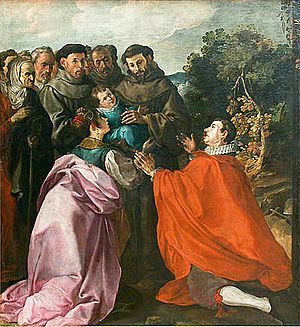Francisco Herrera the Elder facts for kids
Francisco Herrera (1576–1656) was an important Spanish painter from Seville. He helped start the "Seville school" of painting, which was a new and exciting style of art in Spain.
The Life of Francisco Herrera
Francisco Herrera was born in Seville in 1576. He learned to paint from Francisco Pacheco. However, Herrera soon developed his own unique style. He moved away from the older, more careful ways of painting. Instead, he created a bold, strong, and natural style. This new way of painting was later made famous by artists like Diego Velázquez.
Herrera was one of the first artists to use long brushes. This might be why his paintings look so modern and lively. Many art experts believe he helped create the Spanish School of painting. He was a very talented artist and had many students. But he also had a difficult personality, which sometimes made his students leave.
When Velázquez was 13 years old, he studied with Herrera for about a year. Herrera was also skilled at working with bronze and engraving medals. At one point, he had to leave Seville for a short time. He found safety in a Jesuit college. There, he painted a very impressive picture called "The Triumph of St. Hermengild." When King Philip IV saw it in 1621, he was so impressed that he pardoned Herrera right away. Herrera then returned to Seville.
Herrera's paintings are full of energy. His drawings are good, and he used colors so well that his figures seem to stand out from the canvas. Many of his smaller oil paintings show everyday life in Spain. These include scenes of fairs, dances, and insides of inns. His larger works are mostly religious.
In Seville, he painted a "St. Peter" for the cathedral. He also created "The Last Judgment" for the Church of San Bernardo. This painting is often seen as his best work. After doing many projects in his hometown, he moved to Madrid in 1650. There, he became very famous.
In the archbishop's palace in Madrid, there are four large paintings by him. One of these, "Moses Smiting the Rock," is known for its drama and bold painting style. He also painted a series of pictures about the life of St. Ramon in a cloister. Herrera also painted many frescoes, which are paintings done on wet plaster. However, most of his frescoes, including one on the vault of San Bonaventura, have disappeared over time.
Some of his paintings can still be seen today. "St. Basil dictating his doctrine" is in the Louvre Museum in Paris. Another painting, "St. Matthew," is in the Dresden Gallery. Herrera had two sons who were also painters. He was also the godfather of the Portuguese painter Josefa de Óbidos.
Famous Artworks
Francisco Herrera the Elder (El viejo) is known for his strong and skillful painting style. He is called "the elder" to tell him apart from his son, Francisco Herrera the Younger, who was also a famous painter.
Some of his most well-known paintings include:
- The Last Judgment (in Seville)
- A Holy Family (in Seville)
- San Diego (Saint James) (1637), found in a private collection in Madrid.
- Bebedor (1626), located at the Worcester Art Museum.
- Job (1636), a large painting at the Musée des Beaux-Arts de Rouen.
- La Parentela de Jesús (The Family of Jesus), at the Bilbao Fine Arts Museum.
- San Basilio dictando su doctrina (St. Basil Dictating His Doctrine) (1639), a large work at the Louvre Museum in Paris.
- Milagro del Pan y de los Peces (Miracle of the Bread and Fish) (1647), at the Archbishop's Palace, Madrid.
- Ciego tocando la zampoña (Blind Man Playing the Zampoña) (1650), at the Kunsthistorische Museum in Vienna.
See also
 In Spanish: Francisco de Herrera el Viejo para niños
In Spanish: Francisco de Herrera el Viejo para niños


